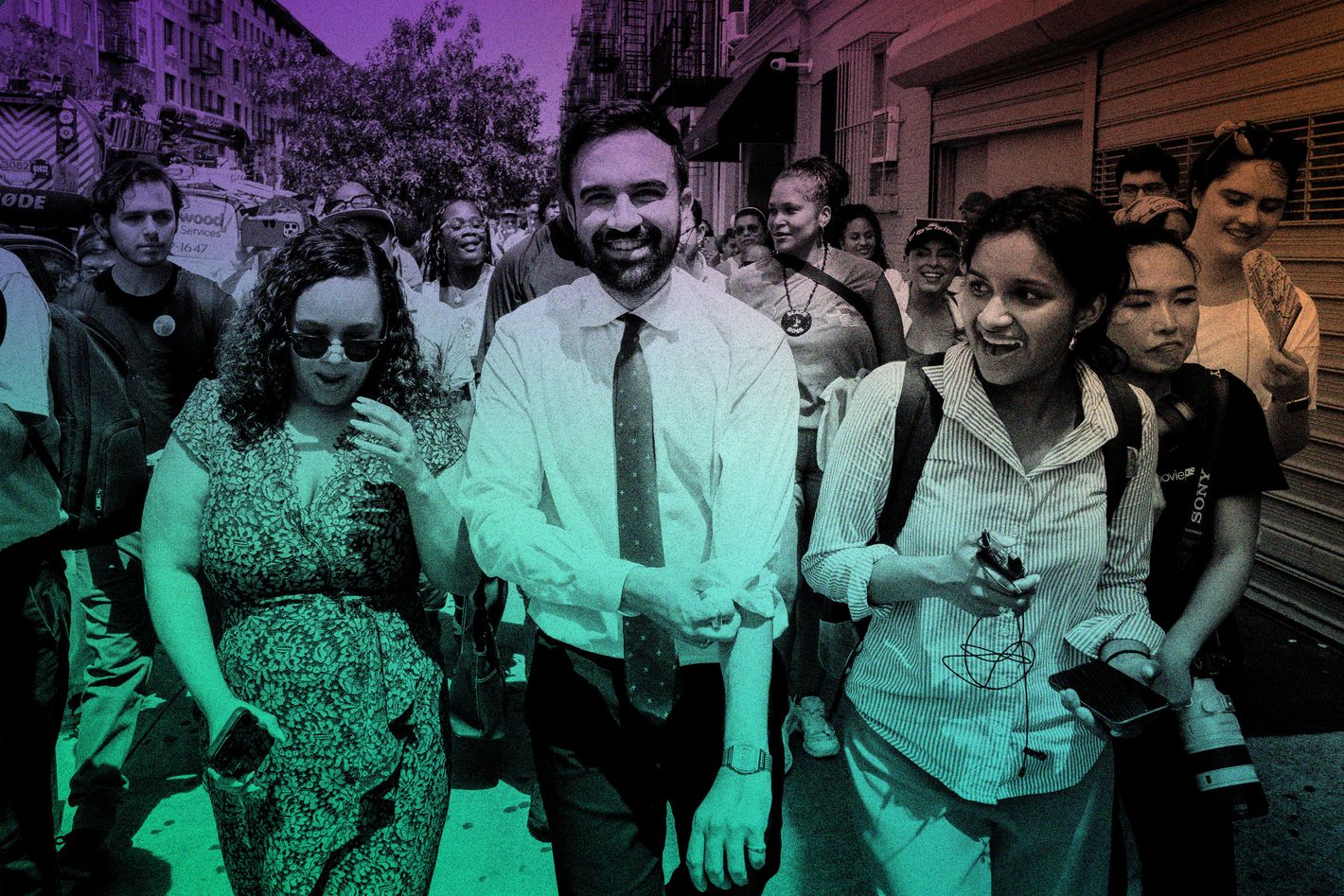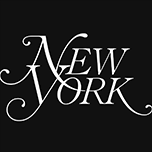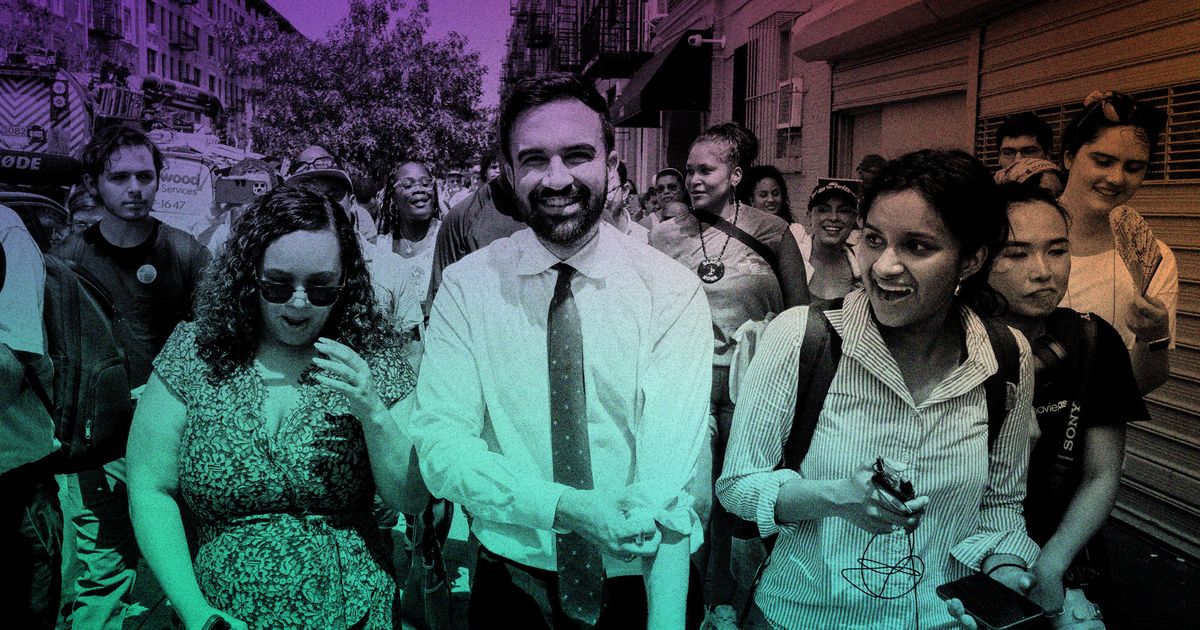 Photo-Illustration: Intelligencer; Photo: Getty Images
Photo-Illustration: Intelligencer; Photo: Getty Images
Last Tuesday, Zohran Mamdani accomplished what few predicted was possible: a decisive defeat of Andrew Cuomo, the veteran politician backed by sizable money and institutional support. To do so, the 33-year-old assemblymember put together a grassroots coalition across racial and cultural lines that stretched across the five boroughs, turning out voters at rarely seen rates. For months, political strategist and researcher Michael Lange has been breaking down the mayoral race on his Substack, The Narrative Wars, analyzing the neighborhoods and bellwether districts that would likely determine the race.
I spoke with Lange about those neighborhoods and the groups who ultimately made up Mamdani’s coalition, where Cuomo underperformed in the city, and how he saw Mamdani’s victory coming.
Last Monday, you put out your own prediction **that Zohran Mamdani would emerge victorious in the primary. How did you come to that conclusion?**I felt like the polls were kind of overindexing their samples and surveys to mirror the 2021 mayoral primary results, but I thought that this time the electorate was going to be different. He was capturing younger voter energy across all races and classes, native New Yorkers, non-native New Yorkers, in a way that the candidates in 2021 just were not doing. And that also extended to rent-stabilized tenants and to South Asian and Muslim voters. The electorate sometimes changes based on who the candidates are — and he was running this excellent campaign. I thought he would really run up the score in young neighborhoods. I thought he would do quite well in left, liberal, and progressive neighborhoods like Park Slope, Morningside Heights, and then I was very bullish about how, particularly with Asian voters and with Hispanic voters, their electorates are kind of younger. And also, as we’ve seen, some realignment toward the Republican Party in those voting blocs takes some of the more “moderate or conservative” voters out of the Democratic electorate, which they also happen to be some of the older voters. So, these demographics that are already young, they’re getting even younger. I just felt like these were real ingredients for him to do quite well with his base.
I also had real questions about Andrew Cuomo being able to motivate, specifically the Black electorate the way that Eric Adams had in 2021. There were folks who would be willing to walk over broken glass to make sure that Eric Adams, one of their own, would have been able to become the second Black mayor. Andrew Cuomo ran this sleepy, arrogant campaign where he’s like, Oh, I’m going to one church a week. That counts as me showing up in your neighborhood. Whereas Eric Adams was out on the trail all the time. So, I anticipated that there would not only be some slippage in terms of Cuomo’s vote share, but that turnout would either plateau or even go down from what it was in 2021.
And then the Mamdani-favorable part of the electorate is super energized, either by him or just by the fact that Donald Trump is president again and Andrew Cuomo is this caricature of the Democratic Party Establishment, basically, kind of all the worst excesses of it. So I thought that group was going to be super motivated to get out to vote. And then I thought Cuomo took his working-class base entirely for granted. If you look at where he started and where he’s finished, he’s just hemorrhaged support.
You look at these neighborhoods, basically a lot of upper Manhattan. You look at Bushwick, you look at Bedford-Stuyvesant. If someone like Zohran Mamdani is exclusively winning the young, professional, college-educated class, that alone can’t sweep every election district in the neighborhood — which is basically what he did. He was making inroads everywhere, right? And that was because the campaign was ubiquitous, really, on all the mediums that people under 50 use. They didn’t have the money to compete on broadcast television with the super-PAC, but their videos were everywhere, and they were being spread organically. And then they were really pressing the flesh, in terms of trying to meet voters where they were, in their native languages, in their neighborhoods, in a way that the Cuomo campaign just never really chose to do. Again, they took their votes for granted in these neighborhoods. Cuomo was only winning housing developments and senior-housing buildings. Even in the really working-class parts of Bed-Stuy and Bushwick that are relatively untouched by gentrification, he was still struggling.
Polls taken before Election Day suggested that Cuomo’s campaign was supported by older and working-class voters and a significant portion of Black and Latino voters, while Mamdani’s supporters seemed to skew younger, whiter, and in a higher income bracket. How would you describe the coalition that ultimately elevated the Mamdani campaign to victory? I wrote about this in the New York Times. It was a coalition of the in-between. Seventy percent of the precincts in New York are people who rent or are majority renter. That was one of Mamdani’s best demographics. And he also did really well with people that are “middle income,” which is kind of an amorphous definition, but it’s like $50,000 to $100,000 a year. He did well in working-class neighborhoods like Elmhurst, which is basically a Chinatown. He did well in middle-class-ish neighborhoods. I would say Astoria is a middle-class neighborhood, also Jamaica Hills, Richmond Hill, these are middle-class areas. And then he also did well in upper-middle-class areas like Fort Greene, Williamsburg, things like that.
But the thread that unites a lot of this is that these were renter-majority communities. Cuomo’s coalition was at the bookend of the economic spectrum. The wealthiest areas: Park Avenue, Madison Avenue, Fifth Avenue, Central Park West, Riverside Drive. That’s really where he was running it up, in addition to Black, middle-class neighborhoods, Orthodox and Hasidic Jewish areas. But then also with very low-income residents, many of whom I think are rightfully distrustful — they’re wary of anyone who’s overpromising things, and they have a relationship that is very real to someone like Cuomo, who’s been around for a long time. He’s a known commodity. Kind of “the devil you know is better than the devil you don’t.” So, Cuomo did really well with lower-income voters, and he also did really well with ultrawealthy voters, and then the middle-class part of his coalition, it was more skewed toward the homeowner areas, I would say.
Where did Cuomo underperform, from what you’ve seen? I think Cuomo underperformed significantly with Chinese voters. I think people predicted that, okay, Zohran will probably do well with South Asian voters, Muslim voters, right? Kind of inspired by one of their own. Cuomo hemorrhaged support in the Chinese community. Even in southern Brooklyn neighborhoods like Bensonhurst and Bath Beach where he has people like Susan Zhuang and Bill Colton supporting him. In this era of institutions that don’t matter, those two have proved their muscle. They have a ton of volunteers, they run an active club. Cuomo lost both of those areas.
I think he also really underperformed with middle-age Hispanic and Black voters. There are all these interesting charts that are coming out about how, again, his support by the end among Hispanic and among Black voters was very much concentrated in the senior demographic and that he was losing voters at the margins.
When Cuomo was last on the ballot in New York City in a primary, he won like 66 percent of the vote against Cynthia Nixon. That was all the way reduced to 36 percent. I mean, this was an epic collapse. I also think Cuomo really underperformed in some middle-class majority-white ethnic areas like Northeast Queens. He only won Staten Island by 9 percent — I mean, the most Italian county in the United States? And I think he, compared to Eric Adams, really underperformed with Black voters. Of the core Cuomo coalition, the only segment that really turned out more than 2021 was Orthodox and Hasidic voters. Whereas Mamdani’s coalition, if you look at where the turnout was compared to Maya Wiley, turnout was going up 40 to 50 percent. All of his voters were so motivated.
Not to get too into the weeds here, but I sometimes look at these little election districts, which are like a couple blocks split up. They’re supposed to have the same amount of people roughly each, but it’s like this little block-level analysis. And I think four years ago, you look at a neighborhood like Astoria, Greenpoint, those little blocks had like 150 votes apiece, 200, 250 votes. Now, they were like 500 votes apiece, 600 votes apiece, 700 votes apiece. And then you go to a place like Southeast Queens and you have these little South Asian election districts. Four years ago, the Black election districts were outvoting these enclaves, two to one, three to one, four to one. And now it’s like, wow, we’re actually sometimes seeing better turnout in South Asian enclaves than we are in Black neighborhoods. That would have been unheard of four years ago. It really just underscores that there was a tremendous enthusiasm gap between Mamdani voters and Cuomo voters.
It seems likely that if and when Mamdani surpasses 50 percent of the vote and wins, it’ll likely be due, in large part, to second-round votes from voters who ranked Brad Lander first. Right now we only have the first-round returns, but are there any signs that the Mamdani-Lander cross-endorsement had an effect on turnout? I think their cross-endorsement had a huge effect, particularly on Lander’s base. I think it created a permission structure maybe for Manhattan voters to go for Mamdani. I mean, in Park Slope, Carroll Gardens, Windsor Terrace, the highest-turnout districts in the city by far, Andrew Cuomo is just getting annihilated. Like 14 percent, 16 percent. I think between the two assembly districts that are Lander’s base, Mamdani beat Cuomo by so much that it was a greater margin than everything Cuomo earned from the Bronx and Staten Island, because there were so many votes from just those two neighborhoods.
**I think an often underdiscussed portion of the city electorate is Asian voters. We saw Mamdani make direct overtures to these communities, filming ads in Hindi, Bangla, and Urdu. You seem to think that paid off.**Absolutely. You contrast that with Cuomo either taking these voters for granted, or just saying, Oh, they’re not going to vote in real enough numbers where I have to care. Not only was Mamdani meeting them where they were at, in native languages, on the mediums they frequent like WhatsApp, things like that, but he was also meeting these folks in their neighborhoods. I think the campaign knocked their one millionth door in Elmhurst. You cannot put a price on showing up in neighborhoods over and over and over again, building that familiarity. That really is the most important thing in politics.
The vast majority of voters are not driven by any particular ideological prescriptions. It is about trust and relationship building. This is kind of the bullish prediction that I’m making for the general election: I think Mamdani will perform a lot better in some of these neighborhoods that saw real shifts to the right over the last four years than people will anticipate. I think it will break people’s brains how well he will do because he will have the time, the money, and the foot soldiers and the infrastructure to really speak to those communities as he did in the primary. I know that is something that matters to him, and I think the cost-of-living message that national Democrats maybe have gotten away from too much, that he really foregrounded in his campaign, is the best way to reach into these pockets.
**Since you mentioned it, do you think there were a lot of Trump-Mamdani voters?**I don’t want to get ahead of myself. I’m sure there were a couple. You don’t want to read into, like, a Democratic primary versus a presidential election, right? A lot of the swings to Trump, it happened from independents or just Republicans who turned out and a couple nominal Democrats. Those are not the folks voting in the primary. Maybe if there were Democrats who swung to Trump and made them less likely to vote in the primary.
But I don’t think it’s also an accident that it’s the guy whose first real breakout moment is like, I’m speaking to Trump voters on Hillside Avenue in Queens, Fordham Road in the Bronx. I don’t think it was a secret that he then goes into some of these neighborhoods where there is some backlash toward how Democrats have handled quality of life or how national Democrats have handled the war in Gaza and he was able to speak to people’s concerns, but also engineer some real turnout. I think it will be a challenge for him to bring some of these communities and voters back into the Democratic Party. But I think it is a challenge he is up for.
This interview has been edited for length and clarity.
More on Mamdani
Israel Was Supposed to Sink Zohran Mamdani‘It’s Nice to Be Right!’Zohran Mamdani on Why He Won
From Intelligencer - Daily News, Politics, Business, and Tech via this RSS feed


